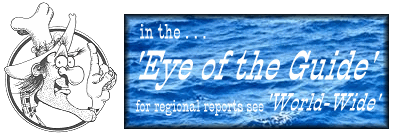It wouldn't be an exaggeration to call the Gulf of Mexico a true fly fisher's
paradise. Against a backdrop of salt marshes, mangroves and tidal creeks, and
amid frolicking dolphins and languorous manatees, anglers take fly rod in hand
and regularly prowl shallow coastal waters in search of game fish from seatrout to
tarpon.
Saltwater fly-fishing is like freshwater fly-fishing only more so. If your
fly-fishing experience has been on the sheltered pools of freshwater trout
streams or in the quiet coves of small bass ponds, then the scale of saltwater
fly-fishing in the Gulf will come as a pleasant surprise.
Fish in these waters can be big, strong, and aggressive. A six-pound redfish
will test your skills and your tackle. A 30-pound cobia will test your mental and
physical toughness as well. Hooking and landing a 100+ pound tarpon on a fly
rod can be the angling test of a lifetime.
Casting a fly rod for saltwater fish is a dynamic activity, and often quite an
athletic one. You fish out where wind is almost always a factor, often blowing
from a direction that makes casting a true challenge. You typically stand
balanced on a raised casting deck, your legs alternately bracing and relaxing as
the boat rocks rhythmically back and forth. You can stand for hours in
mercilessly shining sun and then fish a nervous afternoon calm glancing
frequently behind you at a building storm that threatens at any minute to race
you back to port. Through all of it you cast your fly rod. You catch fish. And you
love it.
Before heading out to fish in the Gulf, you should have already had some
experience with fly casting instruction, the kind that generally starts with 10
o'clock to 1 o'clock diagrams and repeated admonitions against breaking your
wrist. You should know the double haul as well as how to shoot line on both the
back and forward cast. In short, you should pretty well know how to cast.
Less May Be More With Saltwater Flies
Anglers who have fished for finicky freshwater fish often find the
omnivorous appetite of saltwater fish difficult to accept. In mountain streams, for
example, there are many times when freshwater trout will feed on just one insect
or on one type of bait fish, and anglers must imitate it precisely or not catch fish.
The need for the perfect fly or lure drives those anglers to use Latin names to
identify their baits down to the genus and species and to make their lure as
perfect as they possibly can. The concept of "matching the hatch" is so integral
to freshwater trout fishing that fly fishers sometimes think that precise imitation
is the key to all fish.
That is a mistake.
Saltwater fish invariably key in on just a few simple characteristics of a fly to
determine if the fly looks like something to eat. If a fly that is presented to a
saltwater fish is approximately the correct size and shape, and the fly moves like
it is alive, that fish will usually strike it.
In fact, color may only be important in a fly because fish see some colors
better than others, not because a certain color makes your fly look more
realistic. What bait do we think we are imitating when we use a white fly with a
red head? Or an orange fly with a green tail? Highly visible fluorescent
chartreuse has always been one of the best colors for flies along the Gulf Coast,
but try to find a saltwater creature even close to that color.
~ Thomas Broderidge (December 22nd, 1997)
About Tom:
Author of Fly-Fishing The Gulf Coast, Tom Broderidge has been fly-fishing
since 1961 and writing about it since 1983. As a boy in New York, Tom fished for
trout in the famous Catskill Mountain trout streams and for saltwater fish along
the Mid-Atlantic coast. Now living in Gadsden County, Florida, he regularly
fly-fishes the Gulf of Mexico.
Tom teaches year-round fly-tying classes for the City of Tallahassee and
fly-fishing classes for the Florida Game and Fresh Water Fish Commission. He
lectures on fly-fishing and fly-casting and demonstrates fly-tying around the
country at regional conclaves of the Federation of Fly Fishers.
As a free-lance writer, Tom's work has appeared in many outdoor
publications, including Florida Wildlife and
Outdoor Guides News. Since 1989 he
was written regular outdoor columns and feature stories for the
Tallahassee Democrat. ~ DLB
|

